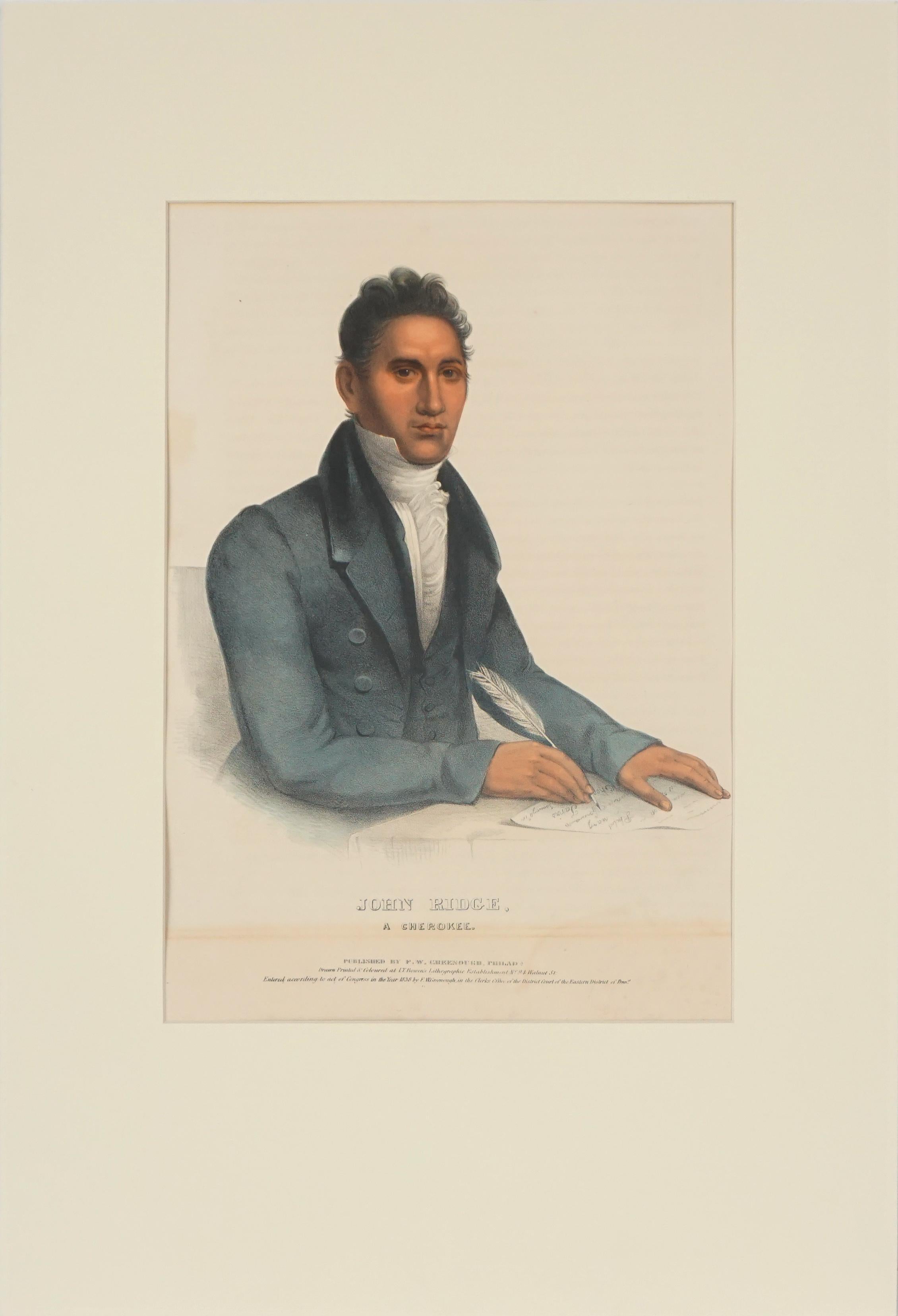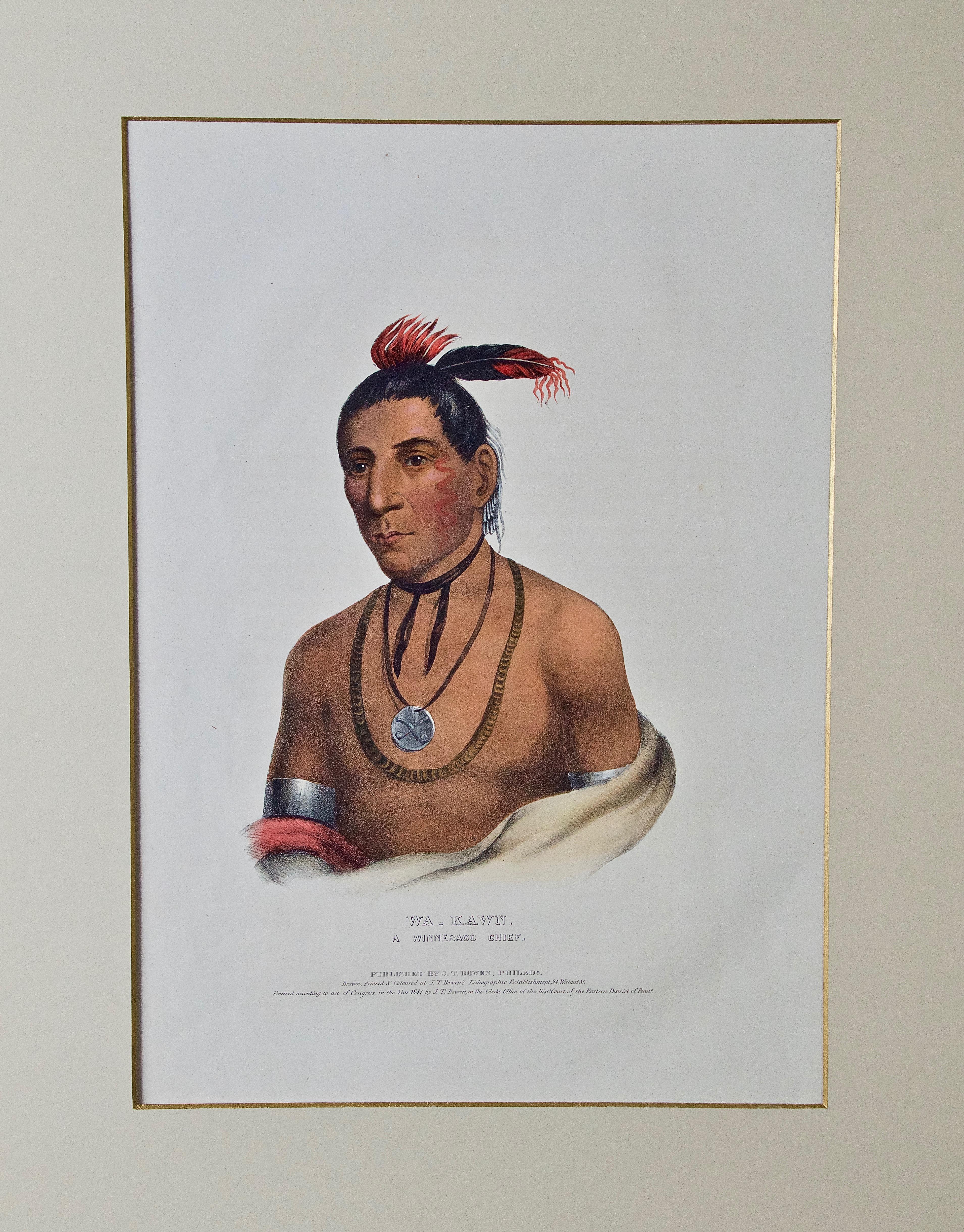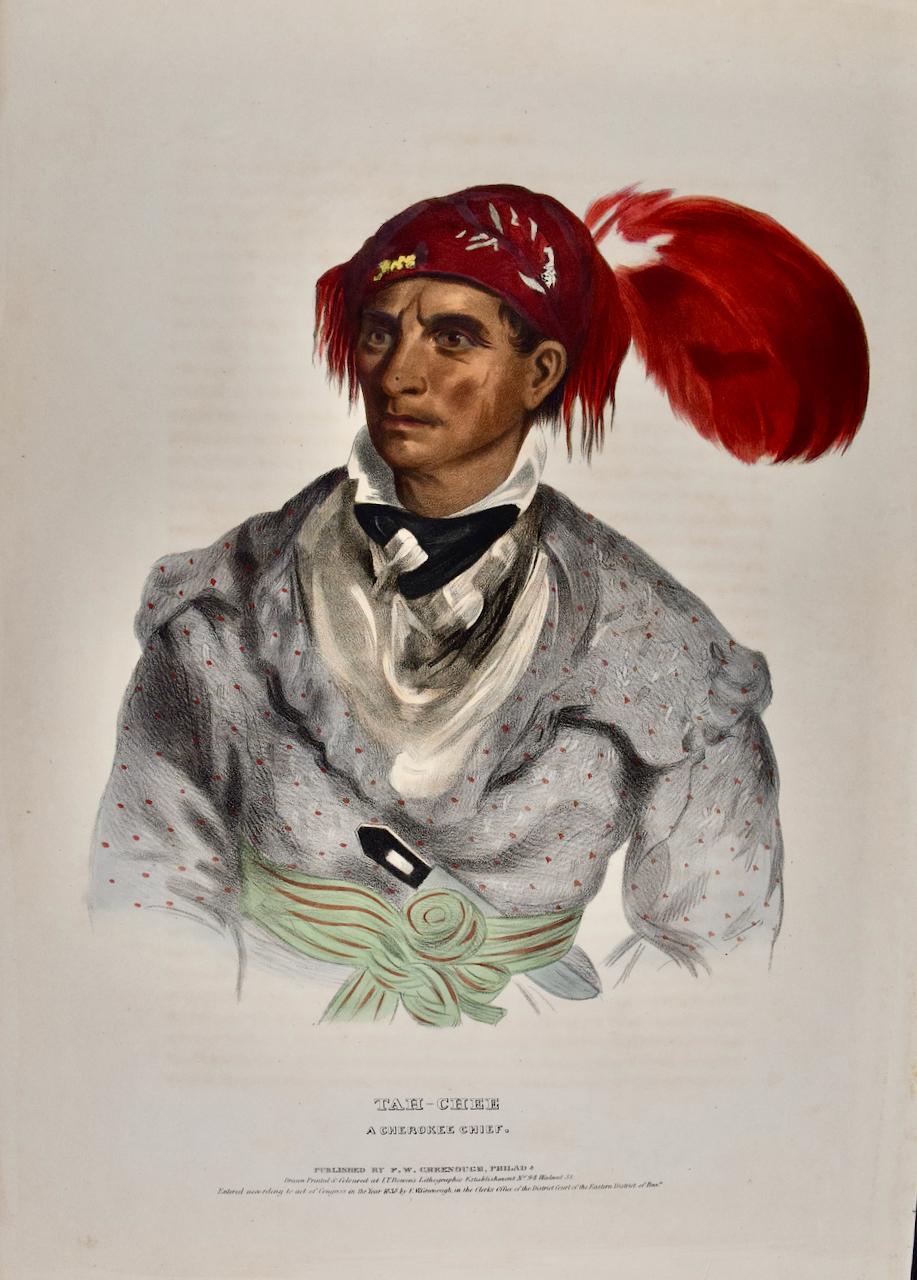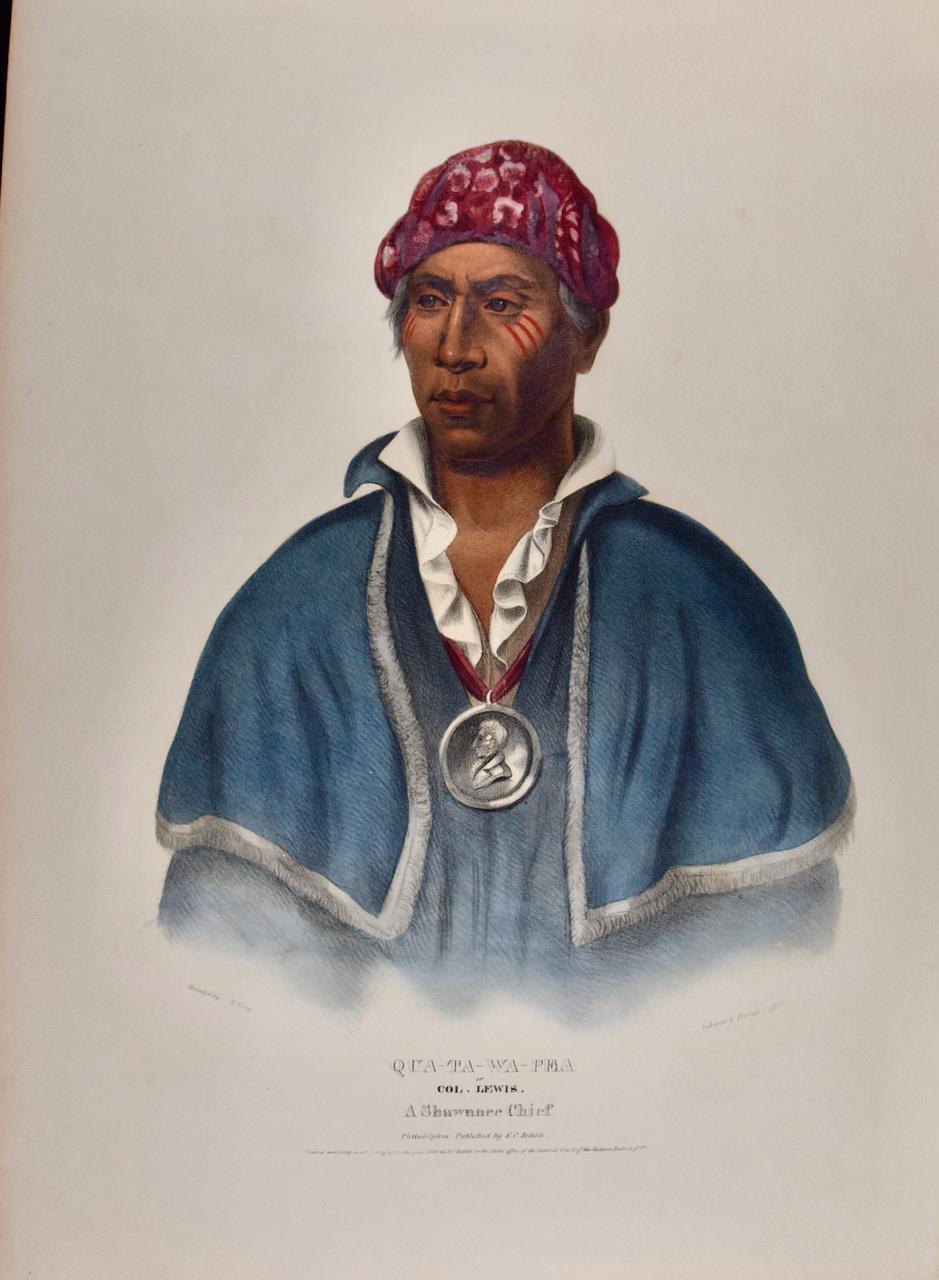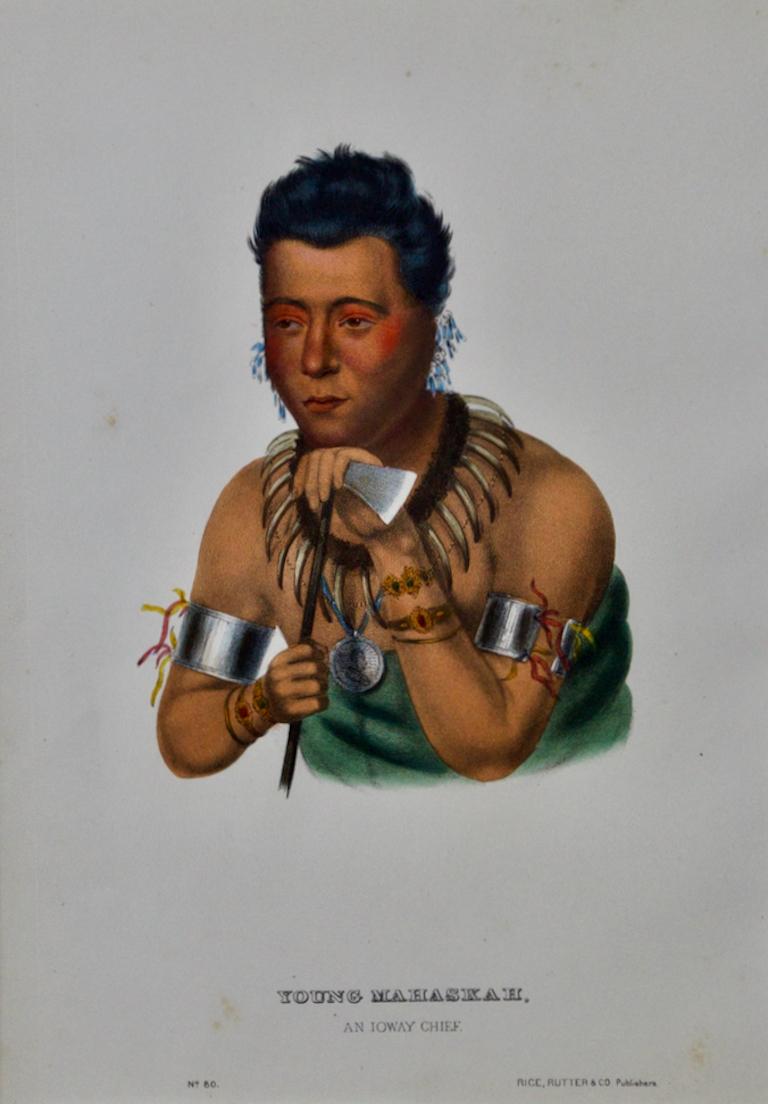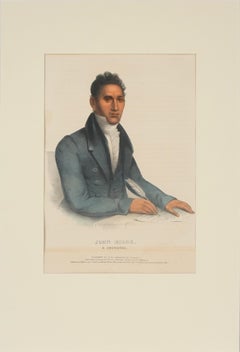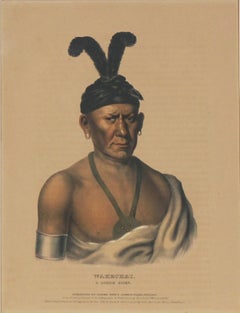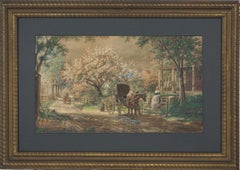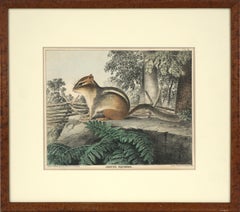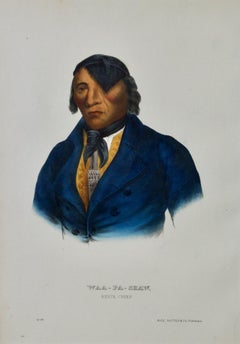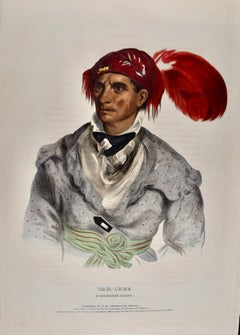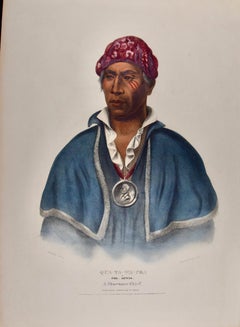Items Similar to Ka-Na-Pi-Ma, An Ottowa Chief Hand-Colored Lithograph
Want more images or videos?
Request additional images or videos from the seller
1 of 9
Charles Bird KingKa-Na-Pi-Ma, An Ottowa Chief Hand-Colored Lithograph1842
1842
$960
$1,20020% Off
£726.51
£908.1420% Off
€834.44
€1,043.0520% Off
CA$1,365.17
CA$1,706.4620% Off
A$1,480.12
A$1,850.1520% Off
CHF 780.02
CHF 975.0320% Off
MX$17,999.72
MX$22,499.6520% Off
NOK 9,704.70
NOK 12,130.8720% Off
SEK 9,177.39
SEK 11,471.7420% Off
DKK 6,229.55
DKK 7,786.9420% Off
About the Item
KA-NA-PI-MA, AN OTTAWA CHIEF., from History of the Indian the Indian Tribes of North America, ca. 1842, hand-colored lithograph
The lithograph by Charles Bird King depicts Ka-na-pi-ma, also known as One Who is Talked of, an Ottawa and was baptized Augustin Hamiln, Jr. When he was young, Catholic Missionaries sent him and his brother from Northern Michigan to the seminary in Cincinnati, Ohio. Eventually, they were sent to Rome to be educated for the priesthood. When his brother died in Rome in 1834, Ka-na-pi-ma returned to his native home. As chief of the Ottawa, he led a delegation to Washington, D.C. in 1835, where this portrait may have been painted. Charles Bird King was known for his realistic and sensitive renderings of his sitters, and his ability to capture their physical features and attire with dignity and attention to detail.
Condition: Good; tonal aging due to age;
Lithographer stone etcher monogram "H.D" lower left on image
Presented in new conservation mat
Paper sheet size: 19"H X 14"W
Image size: 13.38"H x 10.5"W
Mat size:20"H x 16"W
Published by Daniel Rice & James Clark, Philad
"Drawn, Printed and Coloured at the JT. Bowen's Lithographic Establish. N. 94 Walnut St."
"Entered according to act of Congress in the Year 1842 by J.T. Bowen, in the Clerk's Office of the Dist Court of the Eastern District of Penn."
Thomas McKenney, United States Superintendent of Indian Trade, conceived the idea for a series of portraits of prominent Native Americans who visited Washington D.C. in the early 19th century. An established portraitist by the early 1820s, King was commissioned by McKenney to execute the series, resulting in rich character studies of his sitters. Members of the Indian delegation of 1825, such as this sitter, often received copies of their portraits.
Born in Newport, Rhode Island, Charles Bird King became famous for his portraits of distinguished Native Americans. He studied with Samuel King, colonial painter, and then at age 15, ran away to New York City where he worked in the studio of Edward Savage. From 1805 to 1812, he lived in London, studying with Benjamin West and sharing a studio with Thomas Sully.
In 1816, he settled in Washington D.C., becoming the city's first significant resident artist. He did portraits of politicians and then spent 16 years on a commission to paint members of a five-tribe Indian delegation, which came to the city in 1821. The results became the basis of the National Indian Portrait Gallery. The originals burned, but lithography copies remain.
Thomas McKenney was the Superintendent of Indian Affairs under three Presidents -- Madison, Monroe & Adams and was instrumental in having lithographs published of King's work. McKenney's persistence was a blessing to the following generations because it happened that most of the original Charles Bird King paintings were destroyed in a fire at the then new Smithsonian Institution in 1865. So the only record we have today of most of these early Indians are in fact the lithographs made by McKenney. They stand as some of the finest and most important prints ever made in America.
A visitor to his office in the War Department near the White House would have seen a carefully collected ‘museum’ of Indian artifacts. There were buffalo hides, ceremonial pipes, clothing and even a full size canoe over the doorway. Importantly, there were also portrait paintings of many of the tribal Chiefs and Sub-Chiefs that had come to Washington to meet the Great White Father, accept gifts and peace medals and sign peace treaties. Most of these portraits were done by the well known artist Charles Bird King.
The ritual of inviting the Indian Chiefs to Washington was one of the original stated missions of the Lewis & Clark Expedition brilliantly initiated by Thomas Jefferson. The underlying strategy presented to a hesitant Congress by Jefferson was to not only explore the vast continent West of the Mississippi for future settlement but more immediately to control the rivers and fur trade that had been previously dominated by French and English interests.
However, McKenney’s ideas of treating the Indians fairly and with respect were ideologically not in line with the policies of the Andrew Jackson administration and therefore he was forced to resign his post in 1830. By this time, however, he had already had the idea of making a series of lithographs after the collection of Indian portraits. It was a project that took him the next fourteen years to complete -- through years of near bankruptcy, numerous printers and emotional distress.
His persistence was a blessing to the following generations because it happened that most of the original Charles Bird King paintings were destroyed in a fire at the then new Smithsonian Institution in 1865. So the only record we have today of these early Indians are in fact the lithographs made by McKenney. They stand as some of the finest and most important prints ever made in America.
- Creator:Charles Bird King
- Creation Year:1842
- Dimensions:Height: 20 in (50.8 cm)Width: 16 in (40.64 cm)Depth: 0.2 in (5.08 mm)
- Medium:
- Movement & Style:
- Period:
- Condition:Good; tonal aging to paper; wear to edges of paper (see images).
- Gallery Location:Soquel, CA
- Reference Number:Seller: D97371stDibs: LU54215722272
About the Seller
5.0
Platinum Seller
Premium sellers with a 4.7+ rating and 24-hour response times
Established in 1986
1stDibs seller since 2014
3,009 sales on 1stDibs
Typical response time: <1 hour
- ShippingRetrieving quote...Shipping from: Soquel, CA
- Return Policy
Authenticity Guarantee
In the unlikely event there’s an issue with an item’s authenticity, contact us within 1 year for a full refund. DetailsMoney-Back Guarantee
If your item is not as described, is damaged in transit, or does not arrive, contact us within 7 days for a full refund. Details24-Hour Cancellation
You have a 24-hour grace period in which to reconsider your purchase, with no questions asked.Vetted Professional Sellers
Our world-class sellers must adhere to strict standards for service and quality, maintaining the integrity of our listings.Price-Match Guarantee
If you find that a seller listed the same item for a lower price elsewhere, we’ll match it.Trusted Global Delivery
Our best-in-class carrier network provides specialized shipping options worldwide, including custom delivery.More From This Seller
View AllJohn Ridge, A Cherokee Indian & Interpreter Lithograph with Applied Watercolor
Located in Soquel, CA
1838 John Ridge A Cherokee Indian and Interpreter Lithograph with Applied Watercolor
The lithograph depicts John Ridge, a Cherokee interpreter, by Charles Bird King (American, 1785 - 1862), published 1838. Compared to other indian portraits in tribal regalia, King's rendering of John Ridge appears to be different. King portrayed John Ridge in Anglo-American clothing, sitting at a desk with a document and pen in hand—hinting at Ridge’s education and career as tribal leader and politician. King was known for his realistic and sensitive renderings of his sitters, and his ability to capture their physical features and attire with dignity and attention to detail.
Condition: Good; tonal aging due to age; previous mat tonal aging marks
Presented in new conservation mat
Paper size: 19.75"H X 14"W
Image size: 15"H x 10"W
Mat size:24"H x 16"W
John Ridge received his education at Foreign Mission School in Cornwall, Connecticut and served as clerk of the Cherokee National Council. When King painted...
Category
1840s Hudson River School Figurative Drawings and Watercolors
Materials
Watercolor, Laid Paper, Lithograph
Wakechai (Crouching Eagle) A Saukie Chief Lithograph with Applied Watercolor
Located in Soquel, CA
1842 Wakechai (Crouching Eagle) A Saukie Indian Chief Lithograph with Applied Watercolor
The lithograph depicts Wakechai, also known as Crouching Eagle, who was a member of the Sauk and Fox delegation. King renders Wakechai with exceptional detail. The Saukie Chief is adorned with fine accoutrements such as a white fur robe...
Category
1840s Hudson River School Figurative Drawings and Watercolors
Materials
Watercolor, Laid Paper, Lithograph
Rare 19th Century Watercolor and Platinotype -- Coming Home
By Edward Lamson Henry
Located in Soquel, CA
Rare 19th Century Watercolor and Platinotype -- Coming Home
Wonderful and rare 19th Century watercolor and platinotype (Watercolor over Platinum photograph) attributed to Edward Lamson Henry...
Category
Late 19th Century Hudson River School Figurative Drawings and Watercolors
Materials
Watercolor, Paper, Platinum
1830's Hand-colored Lithograph of a Ground Squirrel
By Thomas Doughty
Located in Soquel, CA
Wonderfully preserved hand-colored 1830's lithograph "Ground Squirrel" by Thomas Doughty (American, 1793 - 1856), circa 1830. From "The Cabinet of Natural History and American Rural Sports." Phila: J.&T. Doughty, 1830-32. Sold previously by Bland Gallery, Early 20th century East Side gallery specializing in miniatures. Presented in frame with new acid-free mat under plexiglass. Image size: 7.25"H x 8.75"W.
Doughty’s short-lived magazine “The Cabinet of Natural History and American Rural Sports” is an important imprint in the history of American printing. It contained the first colored sporting prints made in America. Issued in monthly parts and published from the end of 1830 until the spring of 1834, “The Cabinet” featured articles on hunting, detailed descriptions of newly discovered flora and fauna, and some of the finest examples of early American hand-colored lithography. It was originally the work of the Doughty brothers, Thomas and John, with virtually all of the plates being the work of Thomas, who also founded the Hudson River School. But, by the spring of 1832, the partnership had broken up and Thomas had moved to Boston. An abbreviated third volume lacked Thomas’ touch.
Printed by Childs & Inman, the partnership between Philadelphia engraver and lithographer Cephas G. Childs and New York portrait...
Category
1830s Realist Animal Prints
Materials
Paper, Ink
$320 Sale Price
20% Off
Portraits of a man and Woman Circa 1850-1860 Original Oil on Paper
Located in Soquel, CA
Portraits of a man and Woman Circa 1850-1860 Original Oil on Paper
Early American portraits in the style of and possibly by Henry Bryan Hall (English/American, 1808-1861) Later in hi...
Category
Mid-19th Century Hudson River School Figurative Paintings
Materials
Oil, Laid Paper
$2,120 Sale Price
20% Off
Detailed European Landscape in Watercolor and Gouache on Paper
Located in Soquel, CA
Detailed European Landscape in Watercolor and Gouache on Paper
This finely detailed watercolor painting captures a serene countryside setting with an old stone church, a rustic hous...
Category
Mid-19th Century French School Figurative Drawings and Watercolors
Materials
Paper, Watercolor, Gouache
You May Also Like
Waa-Pa-Shaw, Sioux Chief: An Original Hand-colored McKenney & Hall Lithograph
By McKenney & Hall
Located in Alamo, CA
This is an original 19th century hand-colored McKenney and Hall lithograph of a Native American entitled "Waa-Pa-Shaw, Sioux Chief, No. 97", published by Rice, Rutter & Co. in 1865.
...
Category
Mid-19th Century Naturalistic Portrait Prints
Materials
Lithograph
Wa-Kawn, A Winnebago Chief: Folio-sized Hand-colored McKenney & Hall Lithograph
By McKenney & Hall
Located in Alamo, CA
This is an original 19th century hand-colored folio-size McKenney and Hall lithograph of a Native American entitled "Wa-Kawn, A Winnebago Chief", after a painting by Charles Bird Kin...
Category
Mid-19th Century Naturalistic Portrait Prints
Materials
Engraving
Tah-Chee, Cherokee Chief: 19th C. Folio Hand-colored McKenney & Hall Lithograph
By McKenney & Hall
Located in Alamo, CA
This is an original 19th century hand-colored folio-sized lithographic portrait of a Native American entitled "Tah-Chee, A Cherokee Chief", from McKenney and Hall's 'History of the Indian Tribes of North America'. It was lithographed by J. T. Bowen after a painting by Charles Bird King and published by E. C. Biddle in Philadelphia in 1838.
Tahchee's name translates to Dutch in Cherokee, and he became known as William Dutch. He was born in 1790 in the Cherokee Nation, which is now in a portion of Alabama. Tahchee became known as a skilled warrior and leader among his people, and he was eventually appointed as a chief of the Cherokee Nation "Old Settlers". During his time as chief, Tahchee was a rival of the Osage people and he worked to protect the Cherokee people and their land from encroachment by white settlers. He was a strong advocate for maintaining Cherokee sovereignty and cultural traditions, even as pressure mounted from the United States government to remove the Cherokee from their ancestral lands. In 1838, Tahchee and many other Cherokee people were forcibly removed from their homes in what is known as the Trail of Tears...
Category
Mid-19th Century Naturalistic Portrait Prints
Materials
Lithograph
Qua-Ta-Wa-Pea, A Shawnee: 19th C. Folio Hand-colored McKenney & Hall Lithograph
By McKenney & Hall
Located in Alamo, CA
This is an original 19th century hand-colored folio-sized lithographic portrait of a Native American entitled "Qua-Ta-Wa-Pea, A Shawanoe Chief", from McKenney and Hall's 'History of the Indian Tribes of North America'. It was lithographed by J. T. Bowen after a painting by Charles Bird King and published by E. C. Biddle in Philadelphia in 1836. Quatawapea wears a maroon head covering, a white ruffled shirt and blue shawl with gray trim. His presidential peace medal is attached to a maroon fabric...
Category
Mid-19th Century Naturalistic Portrait Prints
Materials
Lithograph
Young Mahaskah, An Ioway Chief: Original Hand-colored McKenney & Hall Lithograph
By McKenney & Hall
Located in Alamo, CA
This an original 19th century hand colored McKenney and Hall engraving of a Native American entitled "Young Mahaskah, An Ioway Chief, No. 80", published by Rice, Rutter & Co. in 1865...
Category
Mid-19th Century Naturalistic Portrait Prints
Materials
Lithograph
Ahyouwaighs, Chief of Six Nations: Hand-colored McKenney Folio-sized Lithograph
By McKenney & Hall
Located in Alamo, CA
This is an original 19th century hand-colored folio size McKenney and Hall engraving of a Native American entitled "Ahyouwaighs, Chief of the Six Nat...
Category
1830s Naturalistic Portrait Prints
Materials
Engraving
More Ways To Browse
Antique Birds
Bird Lithograph
Antique Bird Painting
Antique Bird Lithographs
Indian Chiefs
King Lithograph
Paintings By Thomas King Original
Charles Bird
Antique Canoe
Antique Indian Chief
Thomas Jefferson
Andrew Jackson
Charles Bird King
Buffalo Hide
Chief Painting
Portraits Of Native Americans
King Charles Painting
Antique Pi
